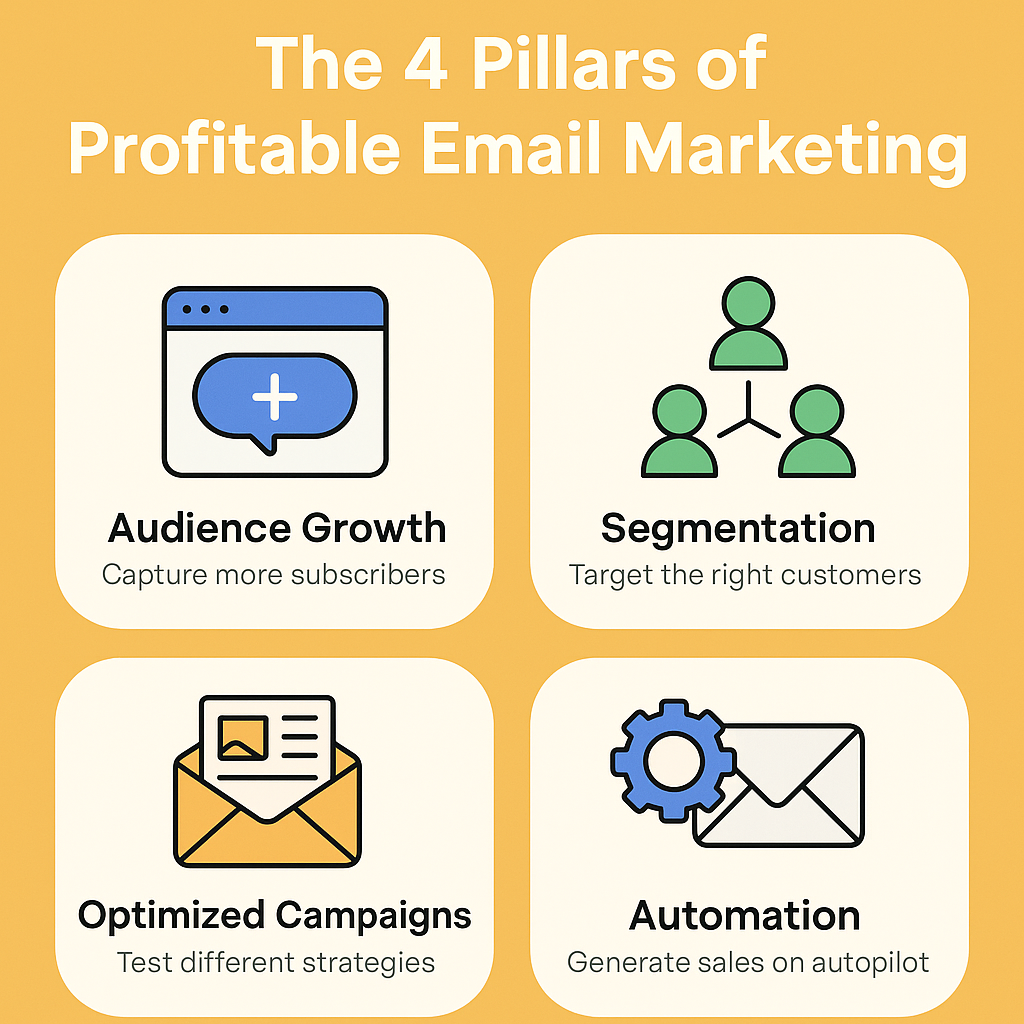Email marketing is the most powerful revenue channel you own—but only if you approach it with the right strategy. Too many businesses treat email as a “send and hope” tool, blasting out promotions without a structure, and then wondering why results fall flat.
The truth is, profitable email marketing is built on four non-negotiable pillars. These pillars separate the brands that see email as an afterthought from the ones that turn their lists into a predictable sales engine.
In this post, we’ll break down the 4 Pillars of Profitable Email Marketing—so you can optimize every campaign, build lasting customer relationships, and unlock the full earning potential of your email list.
While there are countless email marketing strategies you could experiment with, the reality is that 80% of your success will come from mastering just four core pillars:

1. Audience Growth
The bigger and better your email list, the more revenue you can generate—simple as that.
The four primary list growth methods, ranked by importance, are:
- Popup Forms – The most powerful and scalable list growth tool. Every site visitor sees it, which means improving your popup conversion rate directly increases your revenue potential. Double your conversion rate, and over time, you’ll double your email revenue. Popups work better than any other method.
- Post-Purchase Opt-ins – Capture happy customers when they’re most engaged: after a purchase.
- Signup Pages – Standalone landing pages built solely for collecting subscribers.
- Signup Embeds – Static forms embedded into your site.
Too many brands overlook popup forms because they seem “annoying”—but ignoring them means leaving money on the table.
2. Campaigns
Campaigns are one-time broadcasts sent to your list. They keep you top of mind with past customers—people who already know, like, and trust you.
Unlike cold traffic, this audience is much cheaper to convert, making campaigns one of your most cost-effective traffic drivers.
Best practices:
- Send 2–4 campaigns per week (An A/B test is essential to determine the ideal number of campaigns to send to your list for maximum results with your brand.)
- Balance content: educational, entertaining, and promotional.
- Lead with value—nurture emails should outnumber hard sells.
If your emails are relevant and well-designed, your subscribers will look forward to them. The goal is habit formation—getting customers in the routine of opening your emails so you’re always the first brand they think of when they’re ready to buy the products that you sell.
3. Automated Flows
Flows are triggered emails sent automatically when someone takes a specific action on your site—like joining your list, abandoning their cart, or making a purchase.
Ideally, they should account for roughly 30-40% of your email revenue, with campaigns making up the other half.
Why flows are essential:
- Generate revenue on autopilot.
- Convert high-intent visitors.
- Recover lost sales.
- Personalize the customer experience.
- Reduce reliance on campaigns alone.
Once set up, flows work around the clock to nurture leads and move customers through your buying journey.
4. Segmentation
Segmentation is a cornerstone of effective email marketing because it allows brands to send the right message to the right audience at the right time. By dividing subscribers into meaningful groups based on behavior, preferences, or lifecycle stage, marketers can make communications more relevant and engaging.
Top benefits of segmentation:
- Enhanced insights: Segmentation provides data to refine messaging and optimize campaigns.
- Higher engagement: Personalized content leads to increased opens, clicks, and interactions.
- Improved conversions: Targeted messaging drives purchases and repeat sales.
- Stronger customer loyalty: Relevant emails foster trust and long-term relationships.
- Better ROI: Resources are focused on the most receptive audiences, reducing wasted sends.
Final Thoughts
Email isn’t just alive—it’s thriving in today’s noisy digital world. And if you want to be profitable, you don’t need to chase every shiny new tactic. Focus on mastering the fundamentals—that’s where the real results come from.
By focusing on list growth, campaigns, automated flows, and deliverability, you’ll have a high-performing email machine that drives consistent, scalable revenue—while keeping your customer acquisition costs in check.





